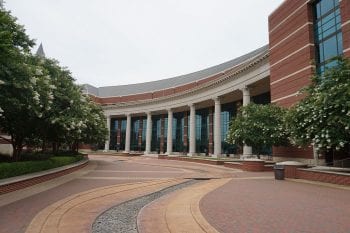The Baylor University Plagiarism Controversy

On May 3rd several users on Twitter posted a video that featured Baylor University student Diamond Dominguez.
In the video, Dominiguez explained how, sometime earlier in the semester, she had an altercation with one of her professors, Dr. Trey Brown.
According to Dominguez, Brown had yelled at her for eating in class and, when she approached him about it in his office, he became hostile, yelling at her, calling the police to remove her and physically shoving her out of his office.
Dominguez goes on to explain that, shortly after that Brown reported her for plagiarism. According to Dominguez, the assignment at issue was a two-point extra credit assignment and she was accused of not properly citing an image that she included with it. Because of this, she may not be able to graduate with her peers in just a few weeks.
Dominguez, and many others on campus, feel that this is a case of racial discrimination. According to Dominguez, she is the only black student in that class and the rule she was yelled at for, eating in class, was one other students broke with impunity.
She believes the plagiarism allegation is racially-motivated retribution and that the punishment far exceeds any alleged crime. It’s a story that’s backed up by another Baylor student, a white student named Hanna Seay.
In a letter she sent to the provost and the president of the school, Seay said that she plagiarized on the same assignment. Though the letter doesn’t indicate if she was caught or not, it paints the picture of an informal assignment that had loose standards. She further says she is not comfortable with the credit she received in the course and asks to be held equally accountable.
The backlash over Dominguez’s story has led to a hashtag #Pressure4DiamondBU trending on Twitter, a student protest at the university and a great deal of media coverage, especially locally.
As of right now, Baylor has responded saying that it “takes seriously any allegations involving academic integrity and unequal treatment” but has not offered any comment on the specific case, citing federal law.
However, that response hasn’t done much to quell the outrage as the Pressure4DiamondBU remains very active and many students have been responding to otherwise ordinary university tweets demanding that Dominguez be allowed to graduate on time.
Whether that will happen or not, we’ll know in a few weeks’ time.
My Quick Take

To be clear, I don’t know any of the individuals involved, I have not reviewed the assignment or the alleged plagiarism and all of the information I have comes from Dominguez and Seay themselves as well as other news coverage.
I also wish to be clear that plagiarizing on any assignment, even an extra credit one, is wrong and violation of virtually any school’s honor code. Even with images used in such assignments, it’s always important to cite sources.
Those things being said, there are a few things that stick out for me with this story.
First, preventing a student from graduating is a fairly extreme measure. There are typically many resolutions between doing nothing and failing a student in such a way they can’t graduate.
The school could, for example, order her to redo the assignment, give zero credit on the assignment, knock a letter grade off the class or require some degree of school/community service. Stopping a senior from graduating over a first instance of plagiarism, especially in this context, is extreme.
Second, the actual plagiarism allegations are about as minor possible. It was a small extra credit assignment and the alleged issue was the use of a photograph that wasn’t cited. It has nothing to do with the text of the research of the work.
Should images be cited in such projects? Of course. Is not doing so a form of plagiarism? Yes. But on the spectrum of academic plagiarism, it rests toward the bottom. This would be different in a photography or art class where the image is the key to the assignment, but this was an environment class.
Finally, the fact that the plagiarism allegations, according to Dominguez, came on the heels of the altercation in Brown’s office raises additional flags. Even if Brown’s interpretation is spot on and the punishment appropriate, it raises questions if Dominguez was singled out for unfair scrutiny.
This is something that’s actually highlighted by Seay’s letter. Though we don’t know for certain if she was caught and confronted by Brown (it’s not mentioned directly in the letter), it’s something of a moot point. If Seay’s plagiarism, which should have been easier to spot as it was text-based, went undetected it could be a sign that Dominguez was getting heightened scrutiny.
When a teacher or school singles out a student or group of students for additional scrutiny, it taints any investigation that follows. It’s impossible for an investigation to be unbiased when it starts from a biased place.
As such, even without knowing too much about this case, there’s simply too many flags for me to ignore. Even if the findings of the case are correct, the timing and handling of it make it difficult to buy into.
I take plagiarism as very seriously, perhaps too seriously sometimes. However, this is a time where the university should find a better way to address the issue than keeping a senior for an additional semester.
Finding Better Practices

Even if Brown and the school is right and everything about this case was above board, it’s very easy to see why Dominguez and other students feel that this is a case of racial discrimination.
Instructors, unfortunately, often struggle to set aside their prejudices when teaching, grading and handling cases of academic integrity. Those prejudices can take any number of forms including race, gender, age, sexuality, socioeconomic status, etc.
Since those prejudices are inherently private, it is difficult, if not impossible, to know if a student was treated fairly when compared to their peers.
There is, however, a solution: Anonymize grading and academic integrity as much as possible.
If the idea seems insane, it’s currently implemented at Western Governor’s University. There, professors don’t grade their own assignments. Instead, they’re given to a grading department that actually handles the markup, including checking for plagiarism.
That department never knows the student’s name and any information they have about the student comes from the assignment itself. While no system can completely eliminate bias, it goes a long way by both removing personal contact with the student and most indicators that could trip such bias.
While that approach may not work in every school, instructors can assign students random numbers to include on their assignments in lieu of their name and keep the key separate from those doing the grading.
There are ways to introduce randomness in this process now that can prevent stories like this one by taking as much of the bias out as possible. Such a system not only protects students but also protects instructors and graders.
Removing bias and the perception of bias from the grading process is good for everyone and, if nothing else, this case illustrates why it’s a good idea for schools to start taking this idea seriously.
Bottom Line
In the end, the issue of bias in grading and academic integrity is something schools need to takes seriously and be proactive, not reactive on. By the time a case like this has come up and made headlines, it’s simply too late.
Fortunately, there are approaches that can help prevent both bias and the perception of bias from impacting grading and academic integrity. Such systems not only stop problems before they start, but also show a thoughtfulness in ensuring that every student gets the same chance.
Though the intent of schools is to be a place where students learn, it should also be a place where the school learns as well. This is an excellent opportunity for just that, not just for Baylor but all schools.
After all, this time around it was Baylor but this story could have just as easily happened almost anywhere else. That’s something that schools would be wise to remember.
Header photo by Michael Barera and used under a CC-BY-SA International License
Want to Reuse or Republish this Content?
If you want to feature this article in your site, classroom or elsewhere, just let us know! We usually grant permission within 24 hours.
